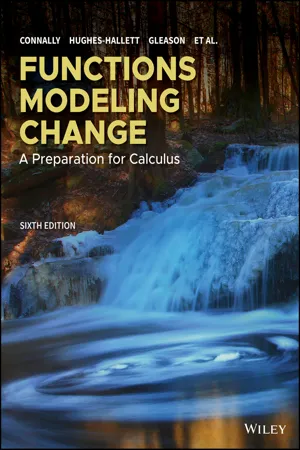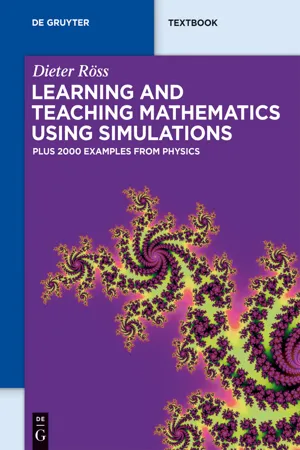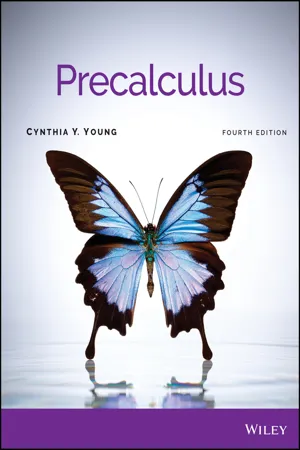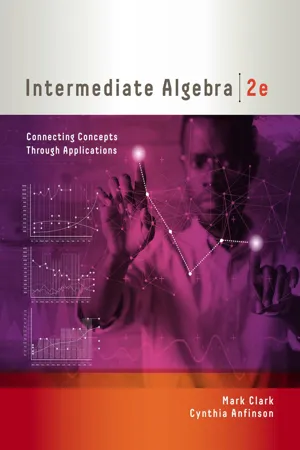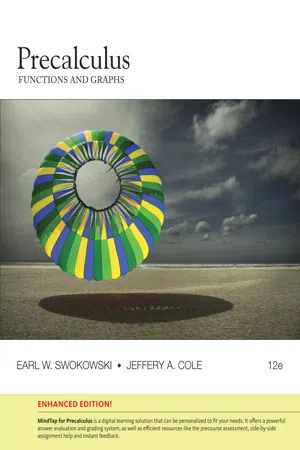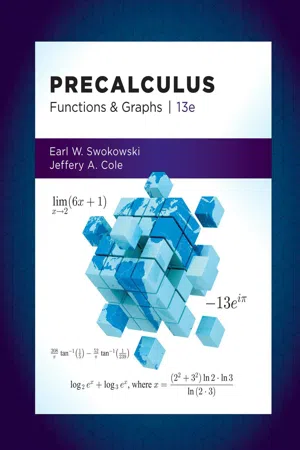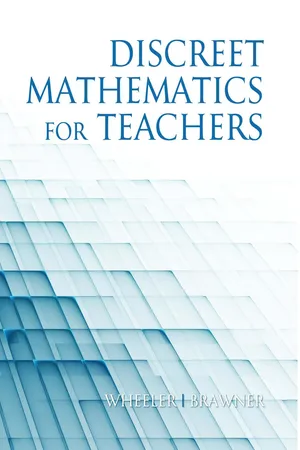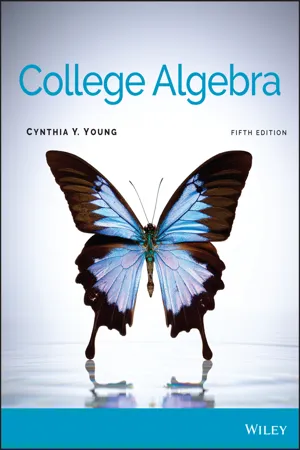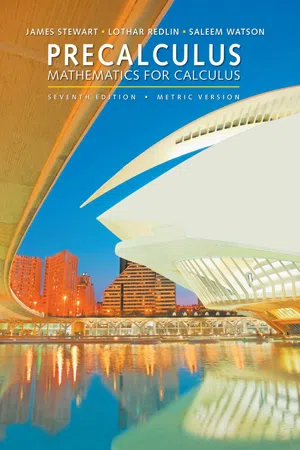Mathematics
Arithmetic Sequences
Arithmetic sequences are a series of numbers in which the difference between any two consecutive terms is constant. This constant difference is called the common difference. The formula for finding the nth term of an arithmetic sequence is given by a + (n-1)d, where a is the first term and d is the common difference.
Written by Perlego with AI-assistance
Related key terms
1 of 5
12 Key excerpts on "Arithmetic Sequences"
- No longer available |Learn more
- Alfred Basta, Stephan DeLong, Nadine Basta, , Alfred Basta, Stephan DeLong, Nadine Basta(Authors)
- 2013(Publication Date)
- Cengage Learning EMEA(Publisher)
6.2 A RITHMETIC S EQUENCES The Definition of an Arithmetic Sequence We’ve already mentioned that a sequence is an ordered progression of real num-bers that may or may not follow a prescribed pattern. If the order is changed, the sequence is changed, so the order of those numbers is fixed once it has been established. Let’s consider a particular type of sequence whose terms follow a specific sort of pattern. The pattern will probably be evident, but we’ll point it out to ensure clarity. { a n } 5 {4, 9, 14, 19, . . .} The terms of the sequence happen to satisfy the condition that they increase by a particular constant value (in this case, 5) from term to term. Such a sequence is called an arithmetic sequence . The emphasis in the word “arithmetic” is on the “met” fragment rather than the “rith” you may be used to using, so the pronunciation is “arith met ic sequence.” Copyright 2013 Cengage Learning. All Rights Reserved. May not be copied, scanned, or duplicated, in whole or in part. Due to electronic rights, some third party content may be suppressed from the eBook and/or eChapter(s). Editorial review has deemed that any suppressed content does not materially affect the overall learning experience. Cengage Learning reserves the right to remove additional content at any time if subsequent rights restrictions require it. Sequences and Series 223 The constant value that is the difference between the terms of an arithmetic sequence is, appropriately, referred to as the common difference for the terms of the sequence, and we say that the terms follow an arithmetic progression . A useful fact about such sequences is that they are completely determined by the value of the first term, a 1 , and the common difference, which we can refer to with the variable d . Let’s examine the terms of an arithmetic sequence a bit more closely by con-sidering the example already presented. - eBook - PDF
Functions Modeling Change
A Preparation for Calculus
- Eric Connally, Deborah Hughes-Hallett, Andrew M. Gleason(Authors)
- 2019(Publication Date)
- Wiley(Publisher)
A sequence can be thought of as a function whose domain is a set of integers. Each term of the sequence is an output value for the function, so = (). Example 3 List the first five terms of the sequence = (), where () = 500 − 10. Solution Evaluate () for = 1, 2, 3, 4, 5: 1 = (1) = 500 − 10 ⋅ 1 = 490 and 2 = (2) = 500 − 10 ⋅ 2 = 480. Similarly, 3 = 470, 4 = 460, and 5 = 450. Arithmetic Sequences You buy a used car that has already been driven 15,000 miles and drive it 8000 miles per year. The odometer registers 23,000 miles 1 year after your purchase, 31,000 miles after 2 years, and so on. The yearly odometer readings form a sequence whose terms are 15,000, 23,000, 31,000, 39,000, … . 1 www.statista.com/statistics/201182/forecast-of-smartphone-users-in-the-us/, accessed March 15, 2017. 13.1 SEQUENCES 13-3 Each term of the sequence is obtained from the previous term by adding 8000; that is, the difference between successive terms is 8000. A sequence in which the difference between pairs of successive terms is a fixed quantity is called an arithmetic sequence. Example 4 Which of the following sequences are arithmetic? (a) 9, 5, 1, −3, −7 (b) 3, 6, 12, 24, 48 (c) 2, 2 + , 2 + 2, 2 + 3 (d) 10, 5, 0, 5, 10 Solution (a) Each term is obtained from the previous term by subtracting 4. This sequence is arithmetic. (b) This sequence is not arithmetic: each term is twice the previous term. The differences are 3, 6, 12, 24. (c) This sequence is arithmetic: is added to each term to obtain the next term. (d) This is not arithmetic. The difference between the second and first terms is −5, but the difference between the fifth and fourth terms is 5. We can write a formula for the general term of an arithmetic sequence. Look at the sequence 2, 6, 10, 14, 18, …, in which the terms increase by 4, and observe that 1 = 2 2 = 6 = 2 + 1 ⋅ 4 3 = 10 = 2 + 2 ⋅ 4 4 = 14 = 2 + 3 ⋅ 4. - eBook - PDF
Learning and Teaching Mathematics using Simulations
Plus 2000 Examples from Physics
- Dieter Röss(Author)
- 2011(Publication Date)
- De Gruyter(Publisher)
4 Sequences of numbers and series 4.1 Sequences and series By Sequence repeated application of the same arithmetic operations on an initial number A , one creates a logically connected sequence of numbers, which show interesting properties (to guess the formation law of a sequence and thus to continue the initial numbers of a given sequence is a popular type of puzzle). In the following the letters m; n; i; j are used to indicate the position of terms in sequences. They can be 0 or positive integers. If there is no upper limit for the number of terms in a sequence or for the terms in a series ( m ! 1 ), we refer to an infinite sequence or series. 4.1.1 Sequence and series of the natural numbers The particularly simple arithmetic sequence of the natural numbers is created via the repeated addition of the unit 1 ; the individual term is characterized by the lower index ( 1; 2; : : : ), which itself is an increasing natural number. A 1 D 1 I A n C 1 D A n C 1 for n 1 ! A n D 1; 2; 3; 4; 5; 6; : : : : We now define the difference quotient for the terms of an arbitrary sequence with different indices i and j . This number is a measure for the change between two terms with different indices and thus for the growth of the sequence in the interval given by the indices: ĩA i;j D A i A j I ĩ i;j D i j difference quotient: ĩA i;j ĩ i;j D A i A j i j : For consecutive terms, the index interval is 1 and the difference quotient is equal to the difference between the terms: ĩA i;i 1 D A i A i 1 I ĩ i;i 1 D i .i 1/ D 1 difference quotient: ĩA i;i 1 ĩ i;i 1 D A i A i 1 : 4.1 Sequences and series 36 For the sequence of the natural numbers, the difference between consecutive terms is constant and equal to 1 . Therefore their difference quotient is also constant and equal to 1 . ĩA i;i 1 D A i A i 1 D 1 ! difference quotient D 1: The arithmetic sequence has constant growth of consecutive terms. - eBook - PDF
- Cynthia Y. Young(Author)
- 2023(Publication Date)
- Wiley(Publisher)
10.1.1 Conceptual Recognize patterns in a sequence in order to identify the general term. The word sequence means an order in which one thing follows another in succession. In mathematics, it means the same thing. For example, if we write x, 2x 2 , 3x 3 , 4x 4 , 5x 5 , ?, what would the next term in the sequence be, the one where the question mark now stands? The answer is 6x 6 . 10.1 Sequences and Series SKILLS OBJECTIVES • Find terms of a sequence given the general term. • Apply factorial notation. • Apply recursion formulas. • Use summation (sigma) notation to represent a series and evaluate finite series and infinite series (if possible). CONCEPTUAL OBJECTIVES • Recognize patterns in a sequence in order to identify the general term. • Understand why (mn)! is not equal to m!n!. • Understand why the Fibonacci sequence is a recursion formula. • Understand why all finite series sum and why infinite series may or may not sum. In This Chapter We will first define a sequence and a series and then discuss two particular kinds of sequences and series called arithmetic and geometric. We will then discuss mathematical proof by induction. Finally, we will discuss the Binomial theorem, which offers us an efficient way to perform binomial expansions. • Find the general nth term of a sequence or series. • Evaluate a finite arithmetic series. • Determine if an infinite geometric series converges or diverges. • Prove a mathematical statement using induction. • Use the binomial theorem to expand a binomial raised to a positive integer power. LEARNING OBJECTIVES 10.1 Sequences and Series 899 A Sequence A sequence is a function whose domain is a set of positive integers. The function values, or terms, of the sequence are written as a 1 , a 2 , a 3 , . . . , a n , . . . Rather than using function notation, sequences are usually written with subscript (or index) notation, a subscript . A finite sequence has the domain {1, 2, 3, . . . , n} for some positive integer n. - eBook - PDF
Intermediate Algebra
Connecting Concepts through Applications
- Mark Clark, Cynthia Anfinson(Authors)
- 2018(Publication Date)
- Cengage Learning EMEA(Publisher)
Begin by finding the first six terms of the sequence. Then plot the terms. n f (n) 1 f 1 12 5 1 212 1 # 1 12 2 5 21 2 f 1 22 5 1 212 2 # 1 22 2 5 4 3 f 1 32 5 1 212 3 # 1 32 2 5 29 4 f 1 42 5 1 212 4 # 1 42 2 5 16 5 f 1 52 5 1 212 5 # 1 52 2 5 225 6 f 1 62 5 1 212 6 # 1 62 2 5 36 10 20 30 f ( n ) 0 n 2 4 1 3 5 6 7 8 –10 –20 PRACTICE PROBLEM FOR EXAMPLE 3 Graph the first six terms of each sequence. Clearly label and scale the axes. a. a n 5 3 1 1 n 2 12 # 5 b. f 1 n2 5 1 212 n Arithmetic Sequences In part a of Example 3, the graph of the sequence of points follows a linear pattern. Looking carefully at the general term, we notice that it has the form of a linear function. In discussing sequences, linear functions are called Arithmetic Sequences. Salary option 1 from the Concept Investigation at the beginning of this section is another example of an arithmetic sequence. Let’s reexamine the table of values from part a of Example 3. Remember when we graphed the terms, we saw that the points followed a linear pattern. n a n Difference Between Outputs 1 –3 a 2 2 a 1 5 4 2 1 232 5 7 a 3 2 a 2 5 11 2 4 5 7 a 4 2 a 3 5 18 2 11 5 7 a 5 2 a 4 5 25 2 18 5 7 a 6 2 a 5 5 32 2 25 5 7 2 4 3 11 4 18 5 25 6 32 Looking at the outputs, we see that to get from one term to the next, we add 7. Another way to look at this situation is that each term differs from the term before it by 7. The number 7 is called the common difference d for this sequence. DEFINITIONS Arithmetic Sequence An arithmetic sequence is a sequence in which successive terms have a common difference. An arithmetic sequence is a linear function with a domain restricted to the natural numbers. Common Difference The common difference d for an arithmetic sequence is the constant amount that each term differs from the previous term. d 5 a n 2 a n 2 1 or d 5 a n 1 1 2 a n Copyright 2019 Cengage Learning. All Rights Reserved. May not be copied, scanned, or duplicated, in whole or in part. - eBook - PDF
- Doug French(Author)
- 2004(Publication Date)
- Continuum(Publisher)
Chapter 11 Sequences and Series Arithmetic Sequences AND SERIES The sequence of odd numbers and other sequences discussed in Chapter 3 are examples of Arithmetic Sequences. The focus in that chapter was on determining an expression for a general term by comparing the sequence with the multiples of the common difference. In the simple case of the odd numbers, this leads to the simple idea that any odd number is one less than the corresponding even number, so that the nth term is given by the expression 2n — 1. Giving meaning to linear expressions of this kind, with the variables taking positive whole number values, and learning to manipulate them and combine them in various ways plays an important part in the early stages of learning algebra. There is a natural progression to expressions where the variable refers to a wider set of numbers, including zero, and rational, negative and real numbers. This is typified by the wider meaning given to the variable x in an expression like 2x - 1 compared to the use of n in 2n -1. Much of school algebra is concerned with problems where the variables are real numbers, but sequences, which are functions of a positive whole number variable typically denoted by «, have a continuing importance. Finding an expression for the nth term of a simple arithmetic sequence becomes one of the first challenges in learning algebra. It is usually simpler, however, to define a sequence inductively because it is natural to see the link between one term and the next. Typically at a later stage it is looked at from this perspective as a prelude to looking at the sum of an arithmetic series. The dialogue which follows is a first step on this path. T: Start with 5 and keep adding 7. What do you get? A: 5, 12, 19, 26, 33 T: So tell us the 10th term. B: 5, 12, 19, 26, 33, 40, 47, 54, 61, 68 [counted on fingers]. It's 68. T: Can anybody find the 10th term without counting out all the numbers? C: 10 times 7, and then 5 more. - eBook - PDF
Precalculus
Functions and Graphs, Enhanced Edition
- Earl Swokowski, Jeffery Cole(Authors)
- 2016(Publication Date)
- Cengage Learning EMEA(Publisher)
Cengage Learning reserves the right to remove additional content at any time if subsequent rights restrictions require it. 9.2 Arithmetic Sequences 653 is a (finite) arithmetic sequence, then are k arithmetic means between the numbers a and b . The process of determining these numbers is referred to as inserting k arithmetic means between a and b. Inserting arithmetic means Insert three arithmetic means between 2 and 9. SOLUTION We wish to find three real numbers , and such that the following is a (finite) arithmetic sequence: We may regard this sequence as an arithmetic sequence with first term and fifth term . To find the common difference d , we may proceed as follows: let in and solve for d Thus, the arithmetic means are ■ An application of an arithmetic sequence A carpenter wishes to construct a ladder with nine rungs whose lengths decrease uniformly from 24 inches at the base to 18 inches at the top. Determine the lengths of the seven intermediate rungs. SOLUTION The ladder is sketched in Figure 2. The lengths of the rungs are to form an arithmetic sequence with and . Hence, we need to insert seven arithmetic means between 18 and 24. Using with , , and gives us or, equivalently, Hence, , and the intermediate rungs have lengths (in inches) ■ It is sometimes desirable to express a sum in terms of summation nota-tion, as illustrated in the next example. Expressing a sum in summation notation Express in terms of summation notation: 1 4 2 9 3 14 4 19 5 24 6 29 E X A M P L E 7 18.75, 19.5, 20.25, 21, 21.75, 22.5, and 23.25. d 6 8 0.75 8 d 6. 24 18 8 d a 9 24 a 1 18 n 9 a n a 1 n 1 d a 9 24 a 1 18 a 1 , a 2 , . . . , a 9 E X A M P L E 6 c 3 c 2 d 22 4 7 4 29 4 . c 2 c 1 d 15 4 7 4 22 4 11 2 c 1 a 1 d 2 7 4 15 4 d 7 4 a 1 2 a 5 9 9 2 4 d a n a 1 n 1 d n 5 a 5 a 1 5 1 d a 5 9 a 1 2 2, c 1 , c 2 , c 3 , 9 c 3 c 1 , c 2 E X A M P L E 5 c 1 , c 2 , . . . , c k FIGURE 2 a 1 18 a 9 24 a 2 a 3 a 4 a 5 a 6 a 7 a 8 Copyright 2017 Cengage Learning. - eBook - PDF
Precalculus
Functions and Graphs
- Earl Swokowski, Jeffery Cole(Authors)
- 2018(Publication Date)
- Cengage Learning EMEA(Publisher)
This is the average of a and b . Note that the three numbers a , a 1 b 2 , and b constitute a (finite) arithmetic sequence with a common difference of d 5 1 2 s b 2 a d . This concept may be generalized as follows: If c 1 , c 2 , . . . , c k are real numbers such that a , c 1 , c 2 , . . . , c k , b is a (finite) arithmetic sequence, then c 1 , c 2 , . . . , c k are k arithmetic means between the numbers a and b . The process of determining these numbers is referred to as inserting k arithmetic means between a and b. FIGURE 1 652 CHAPTER 9 Sequences, Series, and Probability Copyright 2019 Cengage Learning. All Rights Reserved. May not be copied, scanned, or duplicated, in whole or in part. Due to electronic rights, some third party content may be suppressed from the eBook and/or eChapter(s). Editorial review has deemed that any suppressed content does not materially affect the overall learning experience. Cengage Learning reserves the right to remove additional content at any time if subsequent rights restrictions require it. EXAMPLE 5 Inserting arithmetic means Insert three arithmetic means between 2 and 9. Solution We wish to find three real numbers c 1 , c 2 , and c 3 such that the fol-lowing is a (finite) arithmetic sequence: 2, c 1 , c 2 , c 3 , 9 We may regard this sequence as an arithmetic sequence with first term a 1 5 2 and fifth term a 5 5 9 . To find the common difference d , we may proceed as follows: a 5 5 a 1 1 s 5 2 1 d d let n 5 5 in a n 5 a 1 1 s n 2 1 d d 9 5 2 1 4 d a 5 5 9 and a 1 5 2 d 5 7 4 solve for d Thus, the arithmetic means are c 1 5 a 1 1 d 5 2 1 7 4 5 15 4 c 2 5 c 1 1 d 5 15 4 1 7 4 5 22 4 5 11 2 c 3 5 c 2 1 d 5 22 4 1 7 4 5 29 4 . ■ EXAMPLE 6 An application of an arithmetic sequence A carpenter wishes to construct a ladder with nine rungs whose lengths decrease uniformly from 24 inches at the base to 18 inches at the top. Determine the lengths of the seven intermediate rungs. - eBook - PDF
- Ed Wheeler, Jim Brawner(Authors)
- 2013(Publication Date)
- Information Age Publishing(Publisher)
Can a sequence be both arithmetic and geometric? If so, find one. If not, explain why not. 18. Suppose a sequence has first term 2 and third term 18. (a) If the sequence is arithmetic, find the common difference d , and list the first five terms of the sequence. (b) If the sequence is geometric, find two possible values for the common ratio r , and list the first five terms of the geometric sequence in each case. 19. There are 1600 students currently enrolled in the Idaville School District. If the enrollment increases by 5% each year, approximately how many students will be enrolled 5 years from now? 20. Alice starts a new job with an annual salary of $40,000 and a 5% raise each year. At the same time, Bob starts a new job with an annual salary of $50,000 and a $2000 raise each year. Will Alice’s annual salary ever be greater than Bob’s? If so, when? 8 4 C H A P T E R 2 : S E T S , F U N C T I O N S , A N D S E Q U E N C E S 21. A chessboard has 64 squares. Suppose a cent is placed on the first square, two cents on the second square, four cents on the third square, eight cents on the fourth square, and twice as many cents on each successive square. (a) Which will be the first square to have more than a million dollars on it? (b) How much money will be on the last square? S E C T I O N 2 . 5 : R E C U R S I V E S E Q U E N C E S 8 5 2.5 Recursive Sequences With many of the sequences we studied in the previous section, we can describe the apparent pattern by saying how to get from one term to the next. For example, we could tell a student how to write down the arithmetic sequence 1, 4, 7, 10, 13, … with only two instructions: 1. Start with 1. 2. Add 3 to any term to get the next term. Notice that both instructions are necessary if we want the student to write down the particular sequence 1, 4, 7, 10, 13, … . - eBook - PDF
- Cynthia Y. Young(Author)
- 2021(Publication Date)
- Wiley(Publisher)
81. An alternating sequence cannot be an arithmetic sequence. 82. The common difference of an arithmetic sequence is always positive. 722 CHAPTER 9 Sequences, Series, and Probability 9.3 Geometric Sequences and Series SKILLS OBJECTIVES • Determine if a sequence is geometric. • Find the general, nth, term of a geometric sequence. • Evaluate finite geometric series and infinite geometric series (if possible). CONCEPTUAL OBJECTIVES • Understand that the common ratio of a geometric sequence can be positive or negative. • Derive the formula for the nth term of a geometric sequence in terms of n, the first term of the sequence, and the common ratio. • Understand why it is not possible to evaluate all infinite geometric series. 9.3.1 Geometric Sequences 9.3.1 Skill Determine if a sequence is geometric. 9.3.1 Conceptual Understand that the common ratio of a geometric sequence can be positive or negative. In Section 9.2, we discussed Arithmetic Sequences, where successive terms had a common difference. In other words, each term was found by adding the same constant to the previous term. In this section we discuss geometric sequences, where successive terms have a common ratio. In other words, each term is found by multiplying the previous term by the same constant. The sequence 4, 12, 36, 108, . . . is geometric because each successive term is found by multiplying the previous term by 3. 83. Find the sum a + (a + b) + (a + 2b) + · · · + (a + nb). 84. Find the sum ∑ k=−29 30 ln e k . 85. The wave number, v (reciprocal of wave length), of certain light waves in the spectrum of light emitted by hydrogen is given by v = R ( 1 _ k 2 − 1 _ n 2) , n > k, where R = 109,678. A series of lines is given by holding k constant and varying the value of n. Suppose k = 2 and n = 3, 4, 5, . . . . Find the limit of the wave number of the series. 86. In a certain arithmetic sequence a 1 = − 4 and d = 6. - eBook - PDF
- James Stewart, Lothar Redlin, Saleem Watson, , James Stewart, Lothar Redlin, Saleem Watson(Authors)
- 2015(Publication Date)
- Cengage Learning EMEA(Publisher)
Show that the number of gifts received on the 12th day is a partial sum of an arithmetic sequence. Find this sum. DISCUSS ■ DISCOVER ■ PROVE ■ WRITE 78. DISCUSS: Arithmetic Means The arithmetic mean (or average) of two numbers a and b is m a b 2 Note that m is the same distance from a as from b , so a , m , b is an arithmetic sequence. In general, if m 1 , m 2 , . . . , m k are equally spaced between a and b so that a , m 1 , m 2 , . . . , m k , b is an arithmetic sequence, then m 1 , m 2 , . . . , m k are called k arithmetic means between a and b . (a) Insert two arithmetic means between 10 and 18. (b) Insert three arithmetic means between 10 and 18. (c) Suppose a doctor needs to increase a patient’s dosage of a certain medicine from 100 mg to 300 mg per day in five equal steps. How many arithmetic means must be inserted between 100 and 300 to give the progression of daily doses, and what are these means? 8.3 GEOMETRIC SEQUENCES ■ Geometric Sequences ■ Partial Sums of Geometric Sequences ■ What Is an Infinite Series? ■ Infinite Geometric Series In this section we study geometric sequences. This type of sequence occurs frequently in applications to finance, population growth, and other fields. ■ Geometric Sequences Recall that an arithmetic sequence is generated when we repeatedly add a number d to an initial term a . A geometric sequence is generated when we start with a number a and repeatedly multiply by a fixed nonzero constant r . DEFINITION OF A GEOMETRIC SEQUENCE A geometric sequence is a sequence of the form a , ar , ar 2 , ar 3 , ar 4 , . . . The number a is the first term , and r is the common ratio of the sequence. The n th term of a geometric sequence is given by a n ar n 1 Copyright 2016 Cengage Learning. All Rights Reserved. May not be copied, scanned, or duplicated, in whole or in part. Due to electronic rights, some third party content may be suppressed from the eBook and/or eChapter(s). - No longer available |Learn more
- James Stewart, Lothar Redlin, Saleem Watson(Authors)
- 2016(Publication Date)
- Cengage Learning EMEA(Publisher)
In general, if m 1 , m 2 , . . . , m k are equally spaced between a and b so that a, m 1 , m 2 , . . . , m k , b is an arithmetic sequence, then m 1 , m 2 , . . . , m k are called k arithmetic means between a and b. (a) Insert two arithmetic means between 10 and 18. (b) Insert three arithmetic means between 10 and 18. (c) Suppose a doctor needs to increase a patient’s dosage of a certain medicine from 100 mg to 300 mg per day in five equal steps. How many arithmetic means must be inserted between 100 and 300 to give the progression of daily doses, and what are these means? 12.3 GEOMETRIC SEQUENCES ■ Geometric Sequences ■ Partial Sums of Geometric Sequences ■ What Is an Infinite Series? ■ Infinite Geometric Series In this section we study geometric sequences. This type of sequence occurs frequently in applications to finance, population growth, and other fields. ■ Geometric Sequences Recall that an arithmetic sequence is generated when we repeatedly add a number d to an initial term a. A geometric sequence is generated when we start with a number a and repeatedly multiply by a fixed nonzero constant r. DEFINITION OF A GEOMETRIC SEQUENCE A geometric sequence is a sequence of the form a, ar, ar 2 , ar 3 , ar 4 , . . . The number a is the first term, and r is the common ratio of the sequence. The nth term of a geometric sequence is given by a n ar n1 Copyright 2017 Cengage Learning. All Rights Reserved. May not be copied, scanned, or duplicated, in whole or in part. Due to electronic rights, some third party content may be suppressed from the eBook and/or eChapter(s). Editorial review has deemed that any suppressed content does not materially affect the overall learning experience. Cengage Learning reserves the right to remove additional content at any time if subsequent rights restrictions require it. SECTION 12.3 ■ Geometric Sequences 859 The number r is called the common ratio because the ratio of any two consecutive terms of the sequence is r.
Index pages curate the most relevant extracts from our library of academic textbooks. They’ve been created using an in-house natural language model (NLM), each adding context and meaning to key research topics.

